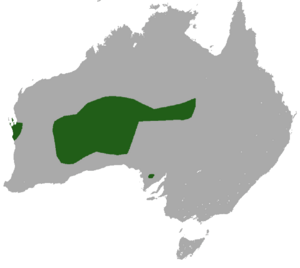Hairy-footed dunnart facts for kids
The hairy-footed dunnart (Sminthopsis hirtipes) is a small, mouse-like marsupial from Australia. It's called "hairy-footed" because it has special silver hairs on the bottom of its back feet. These hairs help it move around!
This little animal is similar to another dunnart called the Ooldea dunnart. Its fur is yellowish-brown on top and white underneath. From its nose to the tip of its tail, it measures about 14.7 to 18 centimeters (about 6 to 7 inches) long. Its body is usually 7.2 to 8.5 centimeters long, and its tail is about 7.5 to 9.5 centimeters long. Its ears are about 1.5 centimeters long. The hairy-footed dunnart is very light, weighing only about 13 to 19 grams, which is less than a small candy bar! Its tail is thin and pinkish-white, and sometimes it can be a bit thicker near its body.
Quick facts for kids Hairy-footed dunnart |
|
|---|---|
| Conservation status | |
| Scientific classification | |
| Genus: |
Sminthopsis
|
| Species: |
hirtipes
|
 |
|
| Hairy-footed dunnart range | |
Contents
Where the Hairy-footed Dunnart Lives
The hairy-footed dunnart lives in three main areas across Australia. One area is near Monkey Mia Bay and Kalbarri in Western Australia. Another large area is where the borders of South Australia, the Northern Territory, and Western Australia meet. Finally, a smaller group lives between the Northern Territory and Queensland border, about 100 kilometers north of the South Australian border.
Hairy-footed Dunnart Habitat
These dunnarts prefer dry and semi-dry places. They live in woodlands, areas with low shrubs, and grassy areas. These habitats provide them with shelter and food.
Hairy-footed Dunnart Life and Reproduction
The hairy-footed dunnart often makes its home in burrows. These burrows are not built by the dunnart itself. Instead, they use burrows made by other creatures like spiders or bull ants.
When Dunnarts Have Babies
Scientists don't know a lot about the exact breeding habits of the hairy-footed dunnart. However, young dunnarts are usually found in their mother's pouch around October. The baby dunnarts then start to come out of the pouch by late April.
What the Hairy-footed Dunnart Eats
The hairy-footed dunnart is a carnivore, meaning it eats meat. Its main diet includes small reptiles, like tiny lizards. It also eats many different kinds of arthropods. Arthropods are creatures with exoskeletons, like insects and spiders.
See also
 In Spanish: Ratón marsupial de pies peludos para niños
In Spanish: Ratón marsupial de pies peludos para niños


